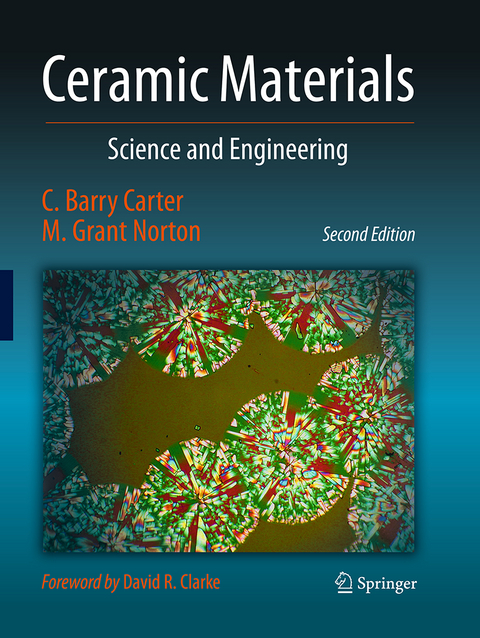
Ceramic Materials
Springer-Verlag New York Inc.
978-1-4939-5053-9 (ISBN)
This course-tested text now includes expanded chapters on the role of ceramics in industry and their impact on the environment as well as a chapter devoted to applications of ceramic materials in clean energy technologies. Also new are expanded sets of text-specific homework problems and other resources for instructors. The revised and updated Second Edition is further enhanced with color illustrations throughout the text.
Dr. Carter is the co-author of two textbooks (the other is Transmission Electron Microscopy: A Textbook for Materials Science with David Williams), co-editor of six conference proceedings, and has published more than 290 refereed journal papers and more than 400 extended abstracts/conference proceedings papers. Since 1990 he has given more than 120 invited presentations at universities, conferences and research laboratories. Among numerous awards, he has received the Simon Guggenheim Award (1985-6), the Berndt Matthias Scholar Award (1997/8) and the Alexander von Humboldt Senior Award (1997). He organized the 16th International Symposium on the Reactivity of Solids (ISRS-16 in 2007). He was an Editor of the Journal of Microscopy (1995-1999) and of Microscopy and Microanalysis (2000-2004); he continues to serve on the Editorial Board of both journals. M. Grant Norton is Professor of Materials Science and Engineering in the School of Mechanical and Materials Engineering at Washington State University. From 2005 to 2011 he served as Associate Dean of Research and Graduate Programs in the College of Engineering and Architecture. Professor Norton obtained his PhDin Materials from Imperial College, London, in 1989,under the direction of Professor B.C.H. Steele and spent a two-year postdoctoral at Cornell University with Professor C. Barry Carter before joining the Washington State University faculty in 1991. In 2003 and 2004 he was an Air Force Office of Scientific Research (AFOSR) Faculty Research Associate at Wright-Patterson Air Force Base in Ohio and spent the 1999/2000 academic year as a Visiting Professor in the Department of Materials at Oxford University. From 2000 to 2005 Professor Norton was Chair of Materials Science at Washington State University and from 2004 to 2007 he held the Herman and Brita Lindholm Endowed Chair in Materials Science. He is author or co-author of about 200 papers in the archival literature, several bookchapters, and two textbooks.
Preface to the First Edition.- Preface to the Second Edition.- Foreword.- PART I: History and Introduction.- Chapter 1: Introduction.- Chapter 2: Some History.- PART II: Materials.- Chapter 3: Background You Need to Know.- Chapter 4: Bonds and Energy Bands.- Chapter 5: Models, Crystals and Chemistry.- Chapter 6: Binary Compounds.- Chapter 7: Complex Crystal and Glass Structures.- Chapter 8: Equilibrium Phase Diagrams.- PART III: Tools.- Chapter 9: Furnaces.- Chapter 10: Characterizing Structure, Defects and Chemistry.- PART IV: Defects.- Chapter 11: Point Defects, Charge and Diffusion.- Chapter 12: Are Dislocations Unimportant?.- Chapter 13: Surfaces, Nanoparticles and Foams.- Chapter 14: Interfaces in Polycrystals.- Chapter 15: Phase Boundaries, Particles and Pores.- PART V: Mechanical Strength and Weakness.- Chapter 16: Mechanical Testing.- Chapter 17: Plasticity.- Chapter 18: Fracturing: Brittleness.- PART VI: Processing.- Chapter 19: Raw Materials.- Chapter 20: Powders, Fibers,Platelets and Composites.- Chapter 21: Glass and Glass-Ceramics.- Chapter 22: Sols, Gels and Organic Chemistry.- Chapter 23: Shaping and Forming.- Chapter 24: Sintering and Grain Growth.- Chapter 25: Solid-State Phase Transformations & Reactions.- Chapter 26: Processing Glass and Glass-Ceramics.- Chapter 27: Coatings and Thick Films.- Chapter 28: Thin Films and Vapor Deposition.- Chapter 29: Growing Single Crystals.- PART VII: Properties and Applications.- Chapter 30: Conducting Charge or not.- Chapter 31: Locally Redistributing Charge.- Chapter 32: Interacting with & Generating Light.- Chapter 33: Using Magnetic Fields & Storing Data.- Chapter 34: Responding to Temperature Changes.- Chapter 35: Ceramics in Biology & Medicine.- Chapter 36: Minerals & Gems.- Chapter 37: Energy Production and Storage.- Chapter 38: Industry and the Environment.
| Erscheinungsdatum | 19.08.2017 |
|---|---|
| Zusatzinfo | XXXIII, 766 p. |
| Verlagsort | New York |
| Sprache | englisch |
| Maße | 210 x 279 mm |
| Themenwelt | Naturwissenschaften ► Chemie ► Anorganische Chemie |
| Naturwissenschaften ► Chemie ► Technische Chemie | |
| Technik ► Elektrotechnik / Energietechnik | |
| Technik ► Maschinenbau | |
| Schlagworte | ceramic applications • ceramic materials and clean energy technologies • ceramic materials chemistry • ceramic materials conduction • ceramic materials energy production and storage • Ceramic materials history • ceramic materials mechanical strength and weakness • ceramic materials models • ceramic materials processing • ceramic materials properties explained • Ceramic Materials textbook • ceramics applications in biology and medicine • ceramics materials characterization book • complex crystal and glass structures • engineering ceramics book • glasses and glass-ceramics • Introduction to ceramic materials • minerals and gems • Principles of Ceramic Processing • Sol-Gel |
| ISBN-10 | 1-4939-5053-3 / 1493950533 |
| ISBN-13 | 978-1-4939-5053-9 / 9781493950539 |
| Zustand | Neuware |
| Haben Sie eine Frage zum Produkt? |
aus dem Bereich


